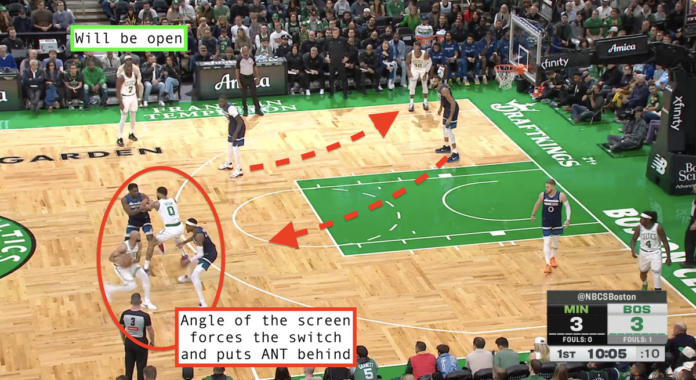#1 – Jaylen Brown, wolves killer
Jerry West once said, “The word ‘dog’ comes up a lot…well, I was a wolf, OK? I used to eat dogs.” Well, Jaylen Brown hunts wolves. On a cold November afternoon, a few days before Thanksgiving, Jaylen decided to bring a long-distance rifle and shoot from deep.
In this game, Jaylen Brown might have delivered his best performance as a finisher so far this season. Compared to his season average, his usage was lower (27% usage rate), but his efficiency was through the roof (77% True Shooting).
What also changed was the percentage of his field goals being assisted. As mentioned in my previous article on his scoring, Brown’s creation volume has increased this season, creating an efficiency dilemma: more creation but less efficiency. Is this what we want from JB? Last night was the opposite. He was assisted on 70% of his field goals, and his efficiency returned just when the Celtics needed it.
His confidence on catch-and-shoot plays electrified the TD Garden early in the game, suffocated the Wolves, and extinguished their hopes. It was just one game, but it’s great to see Jaylen Brown in a role that seems to suit him better. Against a strong defensive team like the Timberwolves, the Celtics needed the best version of JB, and he delivered.
#2 – Jayson Tatum’s screening abilities
The Wolves made life harder for the Jays last night. Instead of soft switching, they worked hard to avoid unnecessary switches. Jayson Tatum countered this by using perfect angles and speed to disrupt the defense and force help.
:no_upscale()/cdn.vox-cdn.com/uploads/chorus_asset/file/25754325/Boston_Celtics___Jayson_Tatum_Screening.png)
Even when switches weren’t on the table, Tatum, an MVP candidate, showed relentless effort to set screens for his teammates and create space. The devil is in the details, and little things like this make you wonder if we sometimes take Jayson Tatum’s team-first mentality for granted.
Night in and night out, Tatum works hard for the team—offensively and defensively—whether or not it shows up on the box score.
#3 – Taking Rudy Gobert out of the paint
The Celtics, though not a rim-heavy team, need to create rim pressure to disrupt opposing defenses. As long as Rudy Gobert is near the rim, the Wolves can stick to their matchups without much thought. However, the Celtics found ways to pull him away from the paint.
Gobert’s natural matchup was Al Horford. When Horford parked in the corner, Gobert could hover near the rim, minimizing the Celtics’ spacing advantage. To counter this, the Celtics shifted Horford to the 5-out position, facing the rim.
:no_upscale()/cdn.vox-cdn.com/uploads/chorus_asset/file/25754330/Boston_Celtics___5_Slot.png)
Another method was to involve Gobert in the action. The Celtics used Horford as a screener, adding a twist. For example, a Ram Screen from Payton Pritchard created a gap between Gobert and Horford. When Horford screened for Tatum, Gobert was forced into the Wolves’ worst-case scenario: switching.
Although hunting was harder than usual, Horford was the key to solving the Gobert dilemma.
#4 – Taking advantage of a rookie
As seasoned hunters, the Celtics know how to find the easiest target—and what’s easier than a rookie? As soon as Rob Dillingham stepped on the floor, the Celtics went right at him.
In the action below, Holiday, guarded by the young Dillingham, sets up a screen for Jaylen Brown. The Wolves, trying to avoid switching, opted for a hedge-and-recover scheme—a difficult coverage to execute.
The rookie, trailing the play, made a classic rookie mistake. He over-helped, leaving Jrue Holiday wide open. At this level, involving inexperienced players who are still learning team coverages is a surefire way to generate easy buckets.
#5 – The 3-Point volume is reaching a new level
Yesterday afternoon, the Celtics set a new benchmark for 3-point volume. While the raw total may not seem staggering due to the slow pace, 60% of their shots came from beyond the arc.
Last season, the Celtics exceeded a 55% 3-point rate only twice. This season, they’ve already done it eight times in just 17 games. When it seemed like the 3-point revolution had peaked, the Celtics found a way to push the boundaries further.
Against a defense as formidable as Minnesota’s, this strategy wasn’t surprising. The Wolves’ length and paint protection made it nearly impossible to score at the rim or rely on the mid-range. The Celtics, as they do best, attacked from deep and pierced the opponent’s heart.
#6 – The Celtics’ defense in the third
At one point in the third quarter, the Celtics held a slim 55-54 lead. A few minutes later, it ballooned to 69-54 thanks to a 14-0 run. What sparked the run? Defense.
Last season, the Wolves struggled against Jason Kidd’s Mavericks, who clogged the paint and dared shooters to take contested threes, or Ant to make impossible drives. The Celtics implemented a similar strategy.
:no_upscale()/cdn.vox-cdn.com/uploads/chorus_asset/file/25754335/Boston_Celtics___Stunt_defense.png)
Anthony Edwards, like Julius Randle in similar situations, struggled to make plays for others. The Celtics crowded the paint, limiting easy passes and forcing Edwards to drive into a wall of defenders. With McDaniels and Gobert on the floor—players the Celtics treated as non-shooters—the Wolves’ spacing issues compounded.
This defensive effort stifled the Wolves, led to transition opportunities, and swung the game in Boston’s favor.
#7 – Sam Hauser and Payton Pritchard’s impact without shooting
Elite shooters sometimes struggle when shots don’t fall. Last night, Sam Hauser and Payton Pritchard combined to hit just two of their 10 attempts from beyond the arc. Yet, their impact was undeniable.
First, their screening created significant issues for the Wolves’ defense. As mentioned earlier, Minnesota’s reluctance to switch meant good screens could force breakdowns. Off the ball, both players created chaos, forcing the defense to stay alert and stretched.
Pritchard also showcased his ability to attack mismatches, confidently driving at Gobert and using his speed and touch to his advantage.
Hauser contributed in different ways, grabbing three offensive rebounds. While seemingly minor, these extra possessions are invaluable in a tight game.
Hauser’s hustle and awareness to secure second chances highlight the importance of role players who excel in the “little things.”
#8 – Offensive struggles in the last three minutes
Despite their defensive dominance, the Celtics managed just three points in the final three minutes of the game—a concerning trend in clutch moments.
Initially, they generated good looks, such as this open three for Jrue Holiday following a first screen for D-White to attract Randle, followed by another screen to set Jrue free:
However, execution faltered. On another possession, Holiday missed a rhythm three after a solid post-up action from Brown:
Late in the game, the Celtics relied heavily on jump shots. Tatum’s step-back mid-range attempt was a high-quality look, but the absence of layups or paint attacks made their offense predictable.
Additionally, poor court geometry hindered their spacing. For example, three players crowded one side, allowing the Wolves to pack the paint and protect Gobert from a potential Tatum drive.
:no_upscale()/cdn.vox-cdn.com/uploads/chorus_asset/file/25754336/Boston_Celtics___Court_Geometry.png)
#9 – No individual answer for Julius Randle
Last night highlighted the kind of player that can give the Celtics trouble. While Minnesota’s poor spacing and Randle’s inconsistent decision-making helped Boston, neither Horford nor Tillman could consistently contain his drives.
Randle’s size and quickness made him a matchup problem on the perimeter, and his physicality overwhelmed smaller defenders like Tatum or Brown in the post.
However, this is why defense is a team effort. As seen in #6, the Celtics’ ability to crowd the paint and force tough decisions neutralized Randle’s impact, showcasing their elite defensive cohesion.
#10 – First night of a back-to-back against the NBA’s best defenses
Tonight, the Celtics face the Clippers—arguably the league’s best defense. Ty Lue’s team excels with a mix of zone and man-to-man schemes, leveraging their length and communication to stifle opponents.
After last night’s grind-it-out defensive battle, we could see another low-scoring affair. How will the Celtics attack the Clippers? Will fatigue from Sunday’s game impact their performance?
We’ll revisit these questions tomorrow, as always.
















